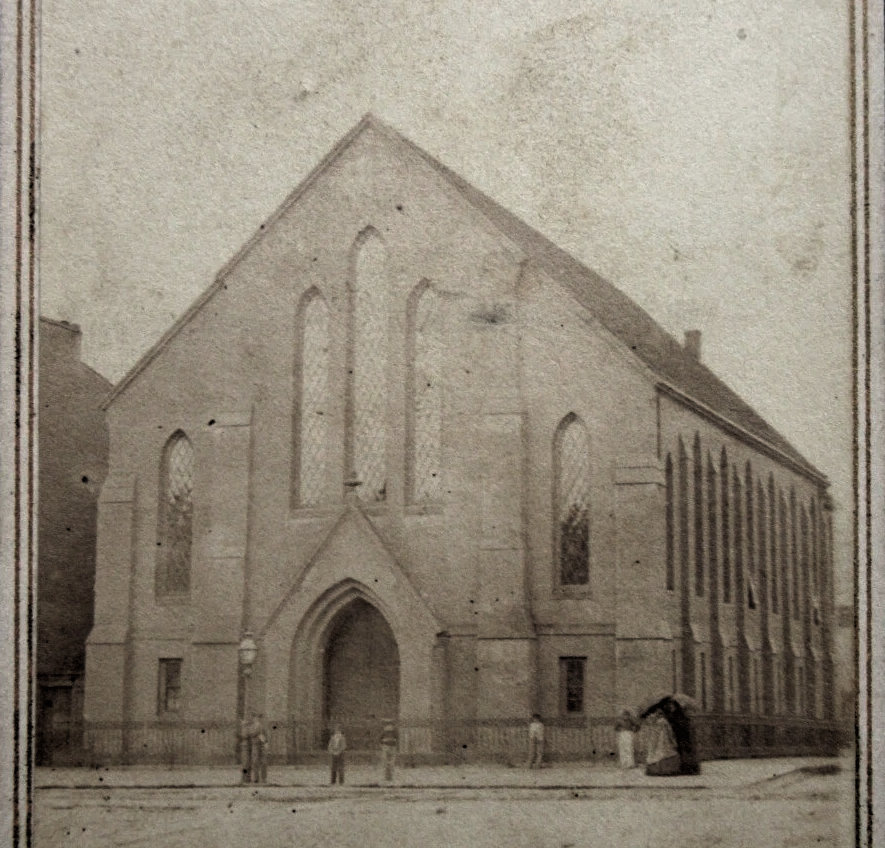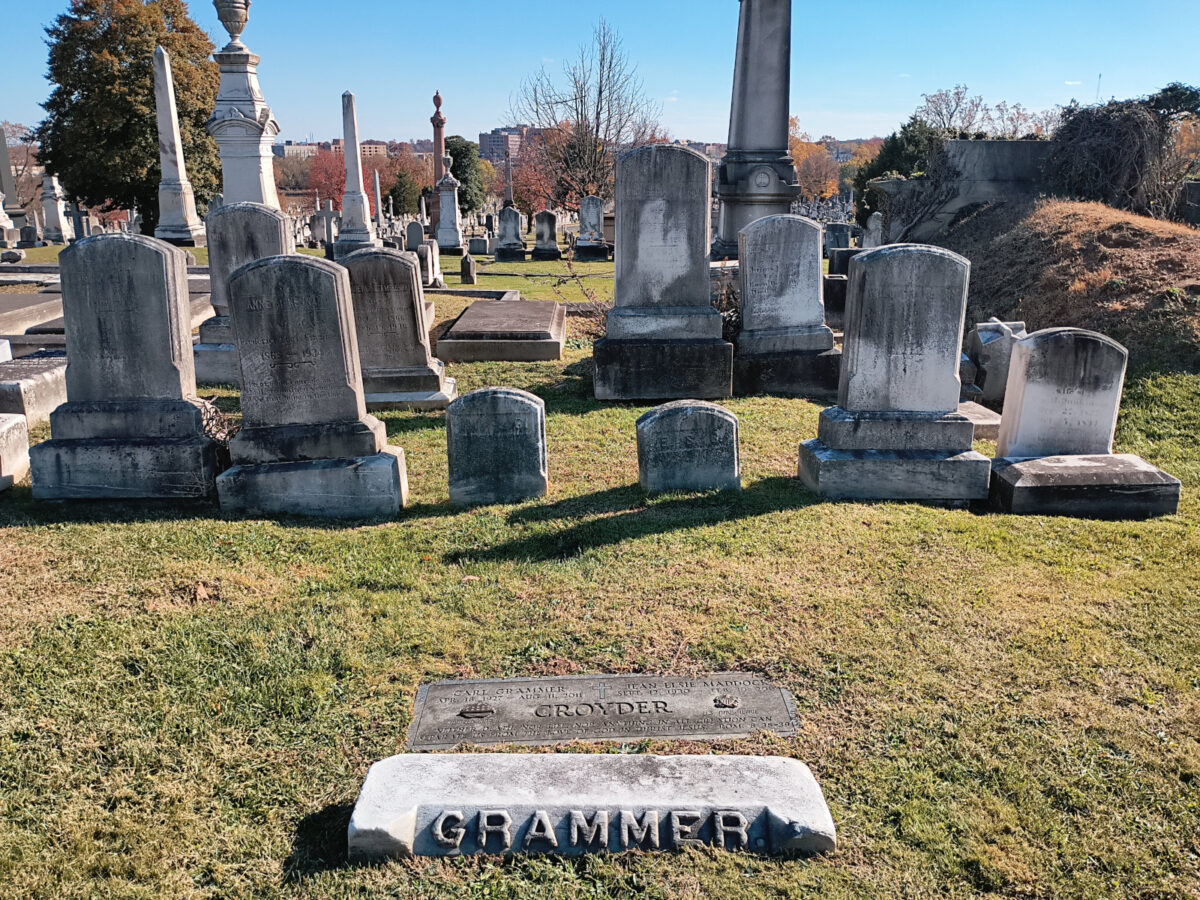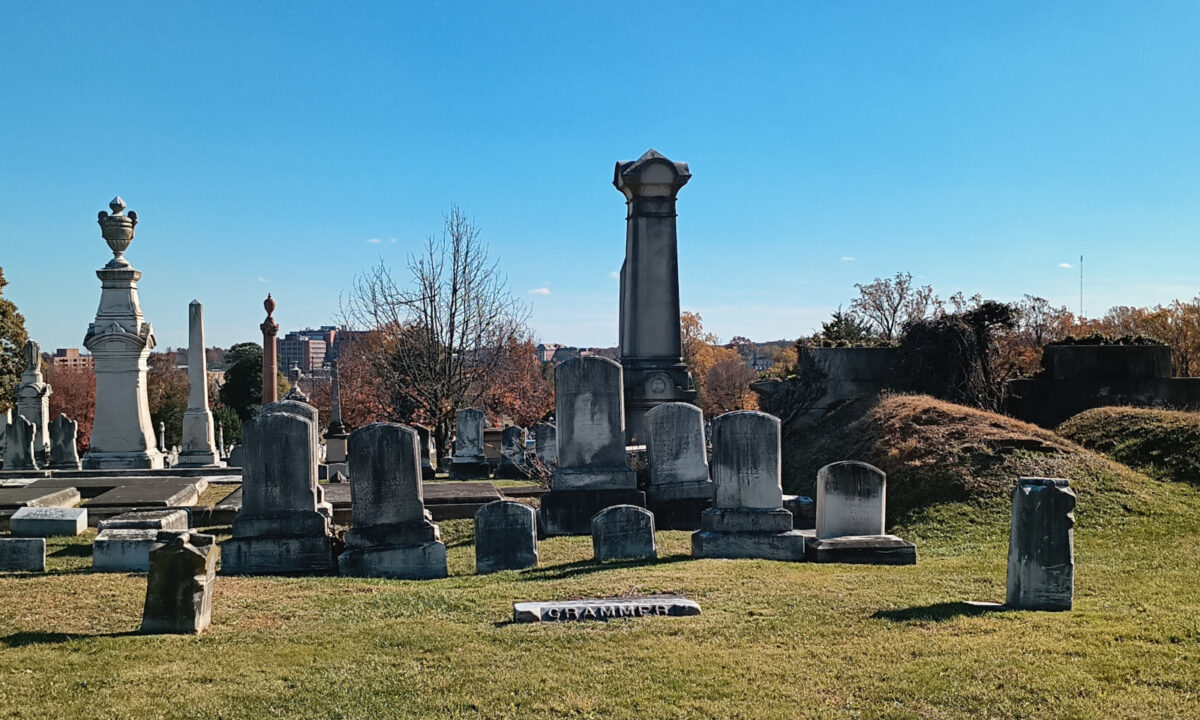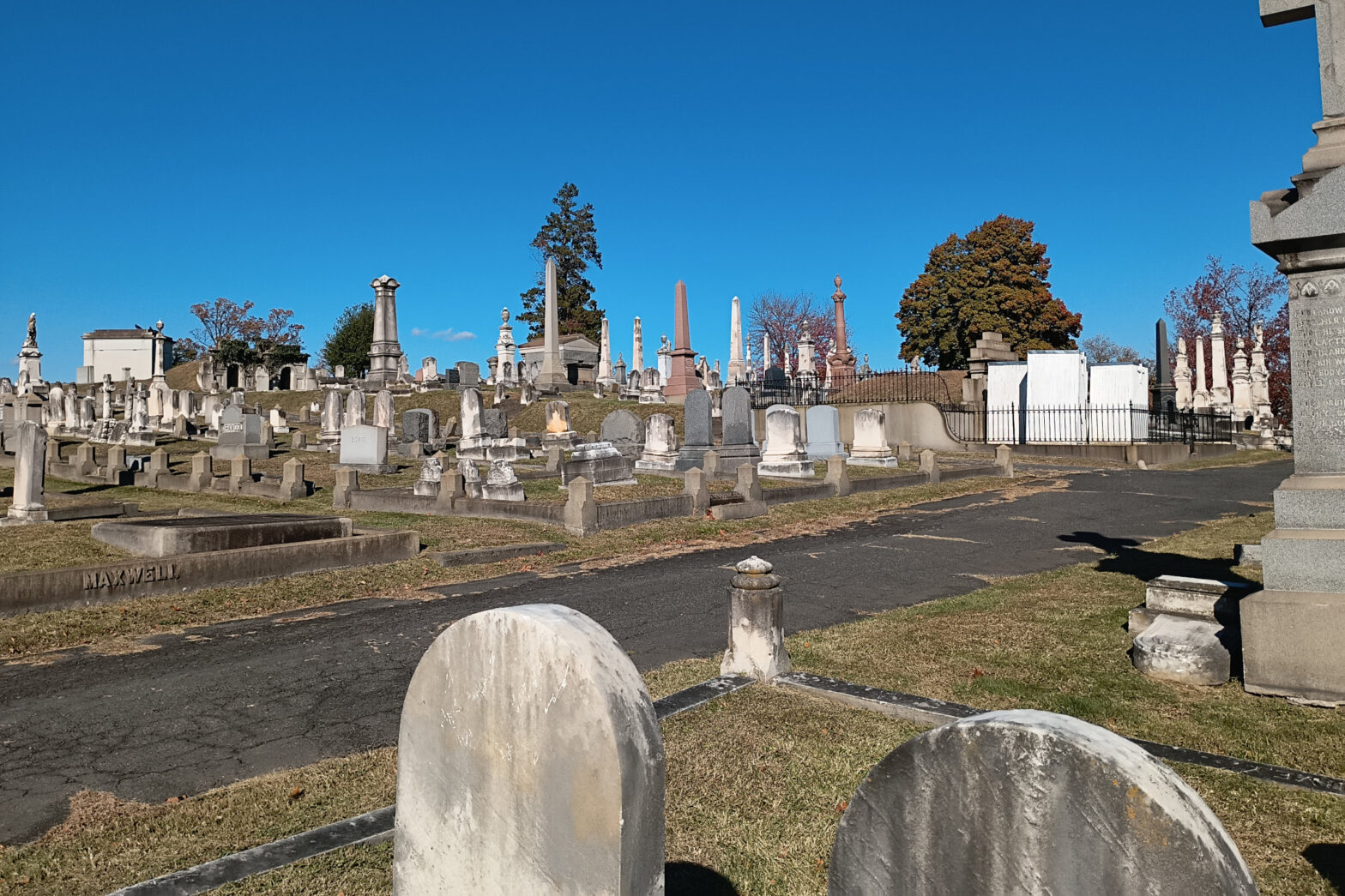I have a weird habit.
I can go to a cemetery and take photographs incidentally of something that I will go back later, sometimes years later, and deliberately search for.
Yes, yes, the human mind is good at finding patterns in the chaos. But it has happened often enough that it’s weird.
Case in point. On July 4, 2020, I went to Baltimore’s Loudon Park Cemetery, visited family and Napoleon’s nephew, and putzed around. I made a blog post with some photos.
And one of those photos has the very thing I was looking for yesterday at Loudon Park. In the background of the photo of the bench memorial for Ensign Markland Kelly, who died at the Battle of Midway, is the family plot for Dr. Julius Grammer, D.D., Episcopal priest and rector of St. Peter’s Episcopal and Trinity Episcopal in Baltimore.
If you don’t want to go to that old post, here’s another angle from July 2020. I’ve circled it in a photo I didn’t use five years ago.

What put me on the trail of an obscure 19th-century Episcopal priest who died in 1902? Genealogy.
My great-great-grandparents were married at Trinity in Baltimore in December 1869. This I knew, I’ve known it for several years, I knew that the man who married them was named George Leakin, I’ve seen the marriage record in the Maryland State Archives index. One of the great puzzles to me is how did William, a widower in Washington, marry Susan, a widow in Baltimore. I don’t know what the connection there was, and I have resigned myself to never knowing. Somehow they connected, that connection a decade later produced my great-grandfather Allyn, and much further down the line I came along. In short, my pre-history runs through this Episcopal church on the corner of Pratt and Broadway that ceased services in 1903.
The parish records of this church happened to have been scanned and put online as a PDF in the Maryland State Archives. And, because I am a well-known weird person, I went through the PDF week before last, these hand-written (and sometimes indecipherable) records of baptisms and marriages, confirmations and weddings, two histories of the church (one handwritten in three stages, one typeset), and the vestry minutes from the final years.

I found the thing I knew should be there — the wedding of my great-great-grandparents, recorded in the marriages.
I found two things I suspected might be there — the baptism of my great-grandfather’s oldest Hardy half-brother, Thomas, in 1861, and the funeral of my great-great-grandmother’s first husband, Henry Hardy, in 1865.
I did not find a baptism for my great-grandfather’s other Hardy half-brother, Henry. Nor did I find any other children of Susan and Henry. And while I found other Hardys, who could be related to Henry Hardy — the sponsor at Thomas’ baptism suggests possibilities there — I did not find any of Susan’s family, the Fenhagens.
But, I do have three data points connecting Susan with this church in the 1860s, and that’s probably the best I am going to do with this church.
I transcribed the two histories into text documents, and went through the vestry minutes to see why the church ceased operations in 1903 and sold the building to a German Reformed congregation after the Great Baltimore Fire in 1904. (The building would later be sold to a Russian Orthodox congregation.) Trinity appeared to be on good financial footing in 1900, though the eastern part of the city posed challenges, but it all seemed to fall apart after Grammer, the penultimate rector, died in early 1902. (I had the odd realization that my great-great-grandmother Susan was still alive when Grammer died, though she was living on Federal Hill at this point and possibly attending what was then called Advent Chapel, as a priest from there oversaw her funeral in August 1902.) There were leadership issues — a rector was hired, but the choice was vetoed by the bishop, and a different man (W.T. Snead) was brought in — and financial difficulties — a summer storm damaged the roof, new musicians were hired, the treasury didn’t have the money to pay the rector’s salary one month and he quit — and what feels like Diocesan politics — the vestry minutes bemoan the bishop and other congregations in the city for being indifferent to the plight.
I don’t know why I wanted to go traipsing through Loudon Park to find Dr. Grammer — my family was never part of his congregation, there was no family connection there — but I saw he was buried in Loudon Park, in section OO (which is near Jerome Bonaparte, Napoleon’s nephew, and family), and I routinely drive past that section when I leave the old part of the cemetery, so why not. A random cleric is no different than looking for Joe Biden’s ancestors or Babe Ruth’s father or H.L. Mencken.
Getting into the old part of the cemetery yesterday was more challenging than I expected — a tree collapsed on Confederate Hill and the road there was impassable.

Sadly, the Robert E. Lee statue was not harmed in the tree’s collapse. You can’t see it anymore — it’s been boarded up since the summer of 2020 — but it’s there.
Still, I was able to get where I wanted to go. I found the flag I had left at my great-great-grandmother’s grave in May was still there. I read Sassoon’s “Dreamers” aloud to my grandfather’s friend Phil, the husband of his first cousin Ida and a veteran of the Meuse-Argonne campaign at the end of World War I. I gave Susan an update on the family, some things I’ve done, and my job search.
Then traipsing I went.
I was going to get to OO eventually, but I was in no hurry, and I looked at places and things I don’t generally look at. I went and located H.L. Mencken. I looked in on Confederate Hill. I took pictures of interesting names that I can potentially use in a book, like “Covington Lang” and “Hamilton Thayer.”

I’ve driven past this grave, that of James Herbert, Confederate cavalry officer and police commissioner of Baltimore, a number of times, but I’d never looked at it that I can recall. The Crossland Arms at the top was the first thing I noticed — the Crossland Arms was the flag Maryland’s Confederate units used during the Civil War — so the biography on the stone, relating his career in the traitor army, didn’t surprise me.
The weird thing to me about what follows is that, in looking at the photos I took, I kept taking photos of where I needed to go… and then I didn’t go there. The header photo for this blog post, it shows where I needed to go. If I’d gone there, if I’d gone past that massive obelisk thing, if I’d gone up the steps in the hillside next to the two crypts…
But no, that’s not where I went. It’s like that time I went to Leesburg, parked maybe forty feet from the graves of James and Roscoe Gardner, then wandered everywhere in that cemetery before seeing them as I went back to my Beetle. And I looked right at their graves as I got out of the car. It was impossible not to.
Yesterday, I even saw something, a flash out of the corner of my eye, that I dismissed as the Star-Spangled Banner that flies near the gate because it would be visible from about where I was, except they didn’t have the 15-star flag flying on the gate pole.
Like I said, weird.
I entered OO well past where I needed to, looked at things, again taking pictures of interesting names, and climbed a steep hill, literally walking right past the Grammer family plot once I reached the top, and make sure I was in the right place by finding the Bonapartes.

I did not shout, “Vive le France! Vive L’Empereur!” in an outrageous French accent as I have been known to do in the past.
Then I turned around and wandered around some more.
I circled around a mausoleum and walked across two slabs before wandering over to the Ensign Markland Kelly memorial to have a sitdown on the bench, partly because I was tired, partly because I needed to have a think — “Where to go? Where to go?”
I sat down on the bench, turned toward the interior of section OO, looked up, and…

…the name “Grammer” stared me in the face, carved into the type of stone I call a “railroad tie.”
I genuinely laughed aloud. In the moment where I was close to giving up, I found exactly what I was looking for.
The Grammer family stones are worn and close to unreadable. I believe that Julius Grammer is one of the two shorter stones in the middle.

Having found him, I didn’t have anything really to say or do. I lingered a little bit, took some more photos, and made my way back to the car.
Grammer’s biography from a page in the Southern Churchman, a page of which is in Trinty’s vestry records.
The Rev. Julius E. Grammer was born in Washington, DC October 6, 1821, and after graduating from Columbian College, in that city, and the Theological Seminary, near Alexandria, was ordained to the diaconate by Bishop Meade in 1855, and to the presbyterate in July, 1856. His first charge was in Smithfield, Jefferson county, Va. For a brief period, beginning in January, 1857, he was assistant minister in Trinity church, Washington, DC. In the summer of 1858 he became rector of St. Peter’s church, Smyrna, Del. In January, 1861, he was elected rector of Trinity church, Columbus, O. where he remained until be was called to the rectorship of St. Peter’s church. Baltimore, Md., in April, 1864. Here he ministered for twenty-seven years, resigning only when he felt that a Younger and more active man was needed under the peculiar circumstances then attending the work at St. Peter’s For a period of eighteen months or more, beginning in May, 1891, he served as assistant minister of Christ church, Baltimore, then under the rectorship of the Rev. George C. Currie, D.D. In January 1894, he was called to the rectorship of Trinity church, Baltimore, where he continued actively engaged in the work of the ministry until the time of his death.
For some years previous to his acceptance of this charge Trinity had been without a settled minister. and it was on the point of being given up and sold. Under. Dr. Grammer’s ministry the work of this old and at one time nearly abandoned church was vigorously revived, a large ground rent was extinguished, and the church building repaired, refitted and beautified without and within. It now stands entirely free from debt, and gives promise of continued life and usefulness.
Dr. Grammer’s life work, however, with which he will be associated and by which he was known and will be remembered, was with St. Peter’s church, Baltimore. When he entered upon his work there in 1864, St. Peter’s, then situated on the corner of Sharp and German streets, was fast becoming a down-town church. Dr. Grammer was young, and the church had had a goodly array of distinguished rectors. But following such men as Drs. Henshaw and Cummins, he did not suffer in comparison with these great masters in pulpit power and parochial administration. In 1866, four years after he he came rector, the old church was sold and the great new one was begun on the corner of Druid Hill avenue and Lanvale street. The new church not being finished until 1871, the congregation worshipped in the meanwhile in the new assembly rooms in Hanover street and the Sunday school room of the new church. In the new edifice Dr. Grammer ministered to a great congregation for a period of twenty years, and gathered around him a strong body of influential and devoted laymen. The church, under his administration, kept fully abreast of the work in the city and Diocese, and among other good works started and sustained one of the most important and successful missions in the city–the Henshaw Memorial church.
Few ministers during this or any other period of our city’s history occupied a more commanding position or achieved a more enviable record for usefulness and influence. His position in the community was unique, Loving and believing in the Church of his intelligence and his heart, he yet sympathized most fully and actively with all the great Protestant bodies in their work for Christ, so that other households of faith beside his own, and all social, philanthropic and educational enterprises felt that they had a friend in Dr. Grammer, and shared more or less in the gifts with which he was abundantly endowed. The temperance movement, the local option cause, the Prisoners Aid Society, the Maryland Sunday School Union, the Maryland Bible Society, the Colonization Society, the Peace Society, the Association for Protecting the Sunday Rest from Infringement or Desecration, all found in him a cordial sympathiser, and most willing and efficient helper.
Being a man of large and varied mental and physical endowments, he employed these to the best advantage. By nature eloquent, he was by cultivation an orator. Widely read and of retentive memory, ho drew upon a vast treasury of quotation, incident and fact in his conversation, sermons and addresses. He loved to preach, and he placed the supreme emphasis in his ministry on the preaching of the Word, to which he felt that he was especially called.

Leaving, I walked through the adjacent family plot and down the stairs next to the two crypts. Just beyond the base of those stairs is the plot of George David Cummins, mentioned and hyperlinked in the biography of Grammer above, who was the founder of the Reformed Episcopal Church. Cummins’ stone is visible in the “face on” pictures of the Grammer family plot.
The proximity makes me wonder if section OO is a bit like “Bishop’s Row” in Baltimore’s Mt. Olivet Cemetery and there were other Episcopal priests in the area on that hill, but I wouldn’t have known what I was looking for… and I was starvating, as an old friend liked to put it. I’d been gallomping around Loudon Park for over two hours at that point, and I felt the siren lure of Five Guys up Wilkens Avenue calling to me.
Which damn near put me in a meat coma while driving home, but that’s a different issue.
I got my Veteran’s Day stuff done at the cemetery, I got a bunch of names to use in a project, I found a random cleric, and I had Five Guys.
It was a good day.
